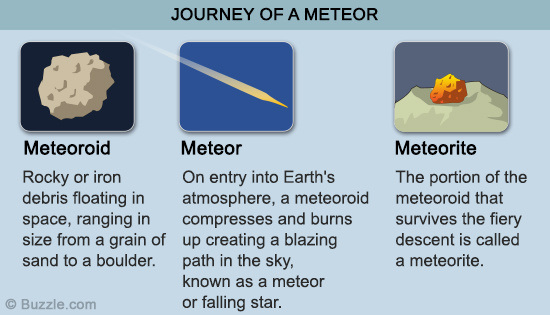
Tell the students that the main topic of the lesson is Meteors/Shooting Stars. Meteoroids, Asteroids and CometsĪsk the students to name the objects that may be found in the Solar System and list them on a board. The students should complete their worksheets by answering each question. This should then be frozen before the activity starts. The discovery of a 180-km wide crater in Mexico is suggested to be responsible for the extinction of dinosaurs over 66 million years ago.įor the comet demonstration, students will need to mix small pieces of gravel and/or sand with water in a cup (or another suitable mould). These range in diameter from a few tens of meters up to about 300 km, and they range in age from the recent times to more than two billion years. Although majority of the meteorites are very small, their size can range from about a fraction of a gram (the size of a pebble) to 100 kilograms or more (the size of a huge, life-destroying boulder).Īlthough active processes on Earth’s surface quickly destroy the impact craters formed by meteorites, about 190 terrestrial impact craters have been identified so far.

If any part of a meteoroid survives the fall through the atmosphere and lands on Earth, it is called a meteorite. They occur when the Earth’s atmosphere passes through a stream of small particles left behind in the comet’s tail. Huge meteor showers, caused by many meteoroids entering the atmosphere in one go, are caused by comets. Others are fragments of asteroids, broken off in collisions. Many are left over from the dust that formed the Solar System. These meteors come from meteoroids, there are three main sources of meteoroids. Most meteoroids that enter the Earth's atmosphere are so small that they vaporise completely and never reach the planet's surface. They are called meteoroids, and according to the International Astronomical Union, they are larger than a micron (a thousandth of a millimetre) and smaller than a meter in diameter.Ī meteor is the flash of light that we see in the night sky when a small chunk of interplanetary debris burns up as it passes through our atmosphere, also known as a shooting star. The space between our planets is populated by billions of smaller particles, which orbit around the Sun. As they near the Sun, the ice on the surface begins to melt, giving them a huge characteristic tail of water, steam and dust.

Comets are made up of rocks, cemented together by ice. They have elliptical (oval shaped) orbits, which bring lead from the outer reaches of the Solar System close to the Sun and then back out again. Because of the gravitational interactions with both Jupiter and the Sun, these asteroids never managed to assemble, stick together and form a planet like the Earth.Ĭomets orbit the Sun in a much different way. Most asteroids orbit the Sun in a ring located between Mars and Jupiter however, some orbit in other places. The Geminid meteoroid stream and asteroid 3200 Phaethon are probably the best-known examples.The Solar System not only consists of planets and satellites but also many other objects such as asteroids, comets and meteoroids.Īsteroids are celestial bodies orbiting the Sun, and they are made of rock or metal (mostly iron) or a combination of the two. On the other hand, meteoroids can also originate from asteroids. Meteoroid streams, consisting of large particles ejected at low speeds and confined to move approximately in the orbit of the parent body, are one result. This drives a gas flux into the adjacent vacuum while drag forces from the expanding gas are exerted on embedded dust and debris particles, expelling them into interplanetary space.

Many meteoroids come from comets: these objects are often called “dirty snowballs” because they contain a lot of ice that sublimates when they come close to the Sun. Meteor, when pieces burn up in the atmosphereĪ meteor is what happens when a meteoroid – a small piece of an asteroid or comet – burns up upon entering Earth’s atmosphere, creating a streak of light in the sky. Its sizes range from 1 meter to about 1000 km. Īsteroids are smaller than a planet, but they are larger than the pebble-sized meteoroids. This can cause small pieces of the asteroid to break off. Sometimes one asteroid can smash into another. Meteoroids, when small pieces of asteroids break offĪn asteroid is a small rocky object that orbits the Sun, mostly between the orbits of Mars and Jupiter.


 0 kommentar(er)
0 kommentar(er)
